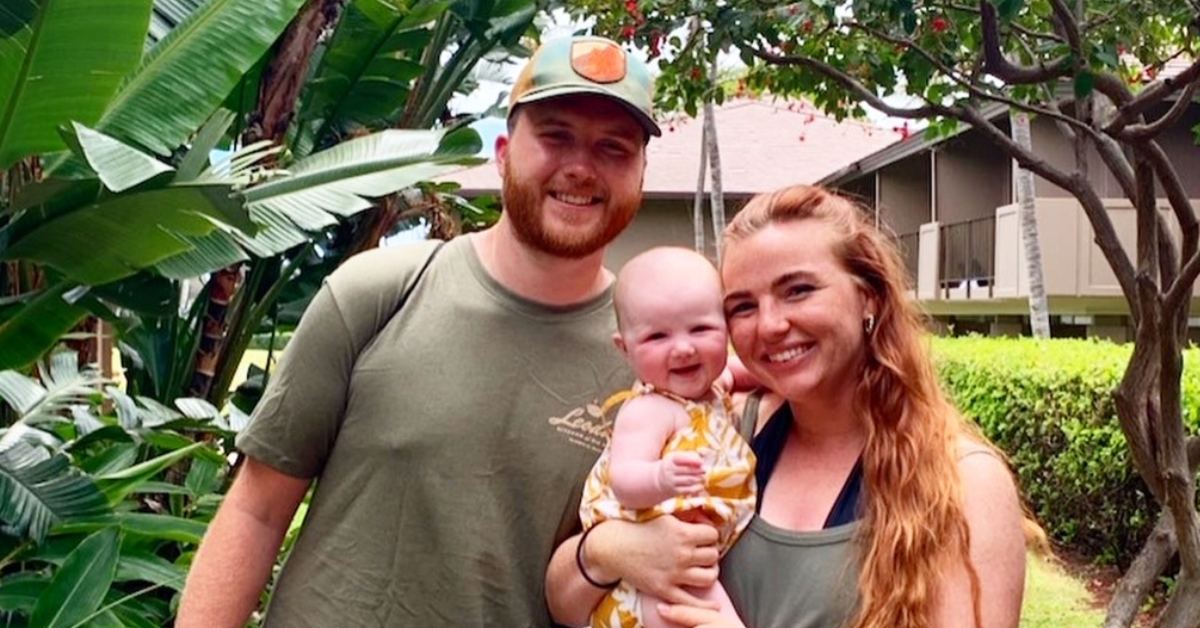
Diabetes was not on my radar before my husband was diagnosed.
Sure, I knew about the history of insulin and had been haunted by pictures of little kids, slowly wasting away without any hope of a cure. A few people on the periphery of my life have had Type 2 diabetes (T2D), but I didn’t know the specifics. One of my friends had Type 1 diabetes (T1D), and the only time I paid much attention to it was when he pulled out his pump before meals.
Diabetes existed outside the focus of my life, which is probably why it took so long for me to realize there was something going on with my husband, Taylor.
Leading Up to Diagnosis
In January 2022, Taylor and I made a few health goals together. We had just welcomed our first baby into the world, and we agreed together that we needed to prioritize what little time we had left to ourselves. Plus, Taylor had a doctor’s checkup in 2021 and was told he had prediabetes, and he wanted to avoid that progression.
Together, we decided to make some changes. He started playing basketball three days a week, and I joined a boxing gym. Sure, we both wanted to lose weight, but the real goal was to get and stay active so we could approach parenthood with as much energy and excitement as possible.
Regardless of our “real goal”, Taylor immediately started losing weight. A lot of weight. To the tune of 2-3 pounds a week, every week, for three months straight.
Basketball was really doing wonders, we thought. We excitedly chatted about his weight loss almost every day. I was proud of him, and he was proud of himself.
With all that was going on in our lives, it was easy to ignore the other things going on, like his constant need to pee. Never mind that he had always had a “bladder of steel” (his words, not mine).
Also, he was always thirsty. He would go to the bathroom at least once an hour, sometimes more. He would wake up in the middle of the night to get more water because “his throat felt like a desert” (again, his words).
We blissfully ignored all of it, instead focusing on his basketball-induced weight loss. We were hitting our goals! We were healthy! Everything was going well.
The Symptoms of Type 1 Diabetes
Then, about three months in, Taylor lost five pounds in one week. For some reason, that was the day I was jolted back into reality. “Do you think it’s something medical?” I asked, and the look on his face confirmed it. Somehow, suddenly, we both knew something serious was happening. I Googled his symptoms:
- Extreme and sudden weight loss
- Constant need to urinate
- Severe thirst
- Brain fog
- Exhaustion
As I scrolled through the results, my heart dropped. “I think you might have diabetes,” was all I could think to say.
We knew about Diathrive Health through a family member, and we were able to get a Diathrive glucometer that same day. Taylor’s fasting blood sugar was 520 mg/dL, which meant nothing to us, but we both saw panic in my family member’s eyes when they read the number. That night, we called a primary care physician, and Taylor was able to get an emergency appointment for the next day.
At the time, Taylor was 27 years old. He was active, ate well, and had never had a problem doing anything he wanted to do. He wasn’t experiencing numbness in his hands or feet or a problem with infections.
The Misdiagnosis
His symptoms were sudden and shocking, and the more I read about it in the days after his 520 mg/dL reading, the more I was convinced that he did not have T2D. It didn’t seem to fit. But the primary care physician he visited was not convinced.
“We never see 27-year-olds who get T1D,” he said. “Only little kids get that diagnosis.” He prescribed Taylor with Metformin, which is a T2D medication, and sent him on his way.
Then, things got more complicated. We had a vacation scheduled two days after Taylor’s initial diagnosis. He was not able to get into an endocrinologist before we left, so he took the medications with him and resigned himself to not eating carbs or sugar while we were gone. The doctor who initially saw him did some bloodwork, but did not get back in touch with us in the timeline he provided.
Taylor was left to go on vacation with T2D medication, vague diet advice, and no official diagnosis. He used Diathrive testing supplies we were able to procure through our family member and taught himself how to use them while we were gone.
It wasn’t until later that we would learn how close he was to serious medical consequences.
Getting the Correct T1D Diagnosis
When we got home from our vacation, Taylor was able to get an appointment with an endocrinologist. To our relief, she recognized what was going on. She confirmed that yes, it was a case of adult-onset T1D, and that no, the $500 Metformin prescription the primary care physician gave us would do nothing to help Taylor’s symptoms.
She prescribed rapid-acting and long-acting insulin and a continuous glucose monitor (CGM), a powerful combination that immediately started working for Taylor. He was finally able to monitor and manage his blood sugar levels. When Taylor was initially diagnosed with T2D, his A1c level was 13. With the correct T1D diagnosis and the proper medications and tools, he was able to get his average blood sugar levels down to a healthier level. Three months later his A1c was down to 7. The correct T1D diagnosis saved his life.
Taylor’s early misdiagnoses, which included both the prediabetes label from his bloodwork and being told he had T2D, held enormous potential for tragedy. It would have ended badly if it weren’t for key people in our lives who saw and understood what was going on.
I’ll repeat it here for the people in the back: Yes, adults can get T1D. In fact, recent data shows that more than half of all new cases of T1D occur in adults, and there is a significant risk in misdiagnosing adults who have T1D with T2D due to key genetic, immune, and metabolic differences which are not widely understood.
Living Life with T1D
I shudder to think about what would have happened if Taylor had not been surrounded by our network of advocates. He would have definitely ended up in a diabetes-related coma. His organs may have started shutting down. He could have died.
I almost lost my husband due to misinformation, ignorance about T1D, and bad diagnoses from physicians who didn’t understand the differences between T2D and adult-onset T1D. I’ll always be grateful for the technology that exists to manage T1D and companies like Diathrive Health who exist to educate and empower people with diabetes, helping them manage the disease and live healthy lives.
Taylor has been living with T1D for almost two years now. He’s learning how to manage the disease through trial and error, lots of frustrating moments at various pharmacies and doctor’s offices, and with the help of a network of people who have come out of the woodwork to support him. Getting diagnosed with adult onset T1D was like waking up to a world that looked the same, but with entirely different rules.
Diabetes was not on my radar when Taylor was diagnosed, but now it’ll forever be a part of our lives. He’s learning how to live with it every day, with the help of our village of advocates, medical professionals, Diathrive employees and loved ones. They have shown us that, while there may not be a cure, there is a way forward in his new world.

